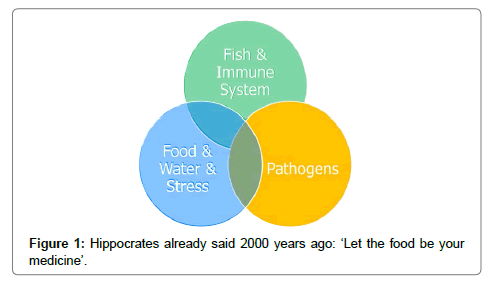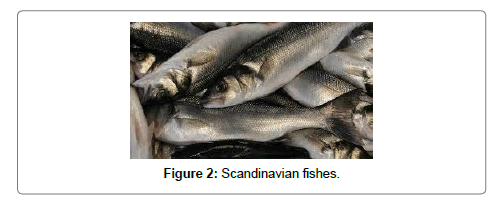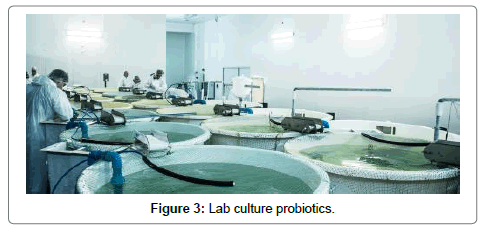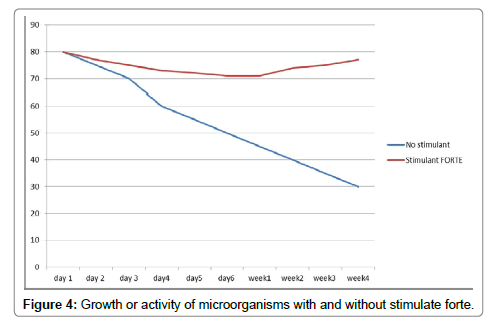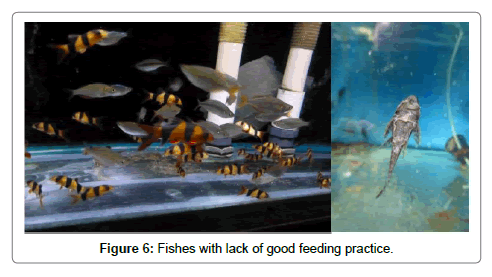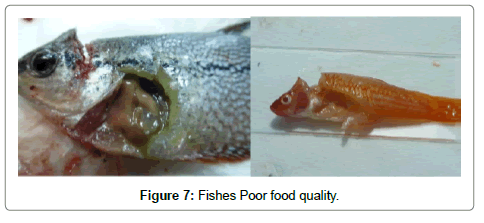Research Article Open Access
Fish Food and Fish Diseases
Bassleer G*Pathologist and CEO for Bassleer Biofish, Herselt, Belgium
- *Corresponding Author:
- Bassleer G
Pathologist and CEO for Bassleer Biofish
Herselt, Belgium
Tel: +32 16 69 68 39
E-mail: gerald@bassleer.com
Received Date: January 20, 2017; Accepted Date: February 06, 2017; Published Date: February 15, 2017
Citation: Bassleer G (2017) Fish Food and Fish Diseases. J Fisheries Livest Prod 5: 220 doi: 10.4172/2332-2608.1000220
Copyright: © 2017 Bassleer G. This is an open-access article distributed under the terms of the Creative Commons Attribution License, which permits unrestricted use, distribution, and reproduction in any medium, provided the original author and source are credited.
Visit for more related articles at Journal of Fisheries & Livestock Production
Abstract
Without too technical information we will explain what we experienced during our 40+ years of feeding ornamental fish at wholesale level. In the early 90s, during our daily practice, we had 1 goal: using a complete food for ornamental fish that would provide high quality fish within 3-7 days, depending on the origin and quality of the fish. Next to the basic ingredients, we have learned in the past 25 years that many other additional feed additives can play an important role to control the health of our fish: to help the immune (defense) system of the fish, to assist in faster repair after damage, to prevent or control infections, etc. In general, with the recent studies and experience (especially in aquaculture) we learned to understand the health benefits of a functional fish food= a food that gives more benefits than just ‘feeding fish’, a food that can be seen as a “nutricament”= nutritional medication with products from nature, avoiding (preventing) the use of medications.
Keywords
Ornamental fish; Omega-3 DHA fatty acids; Nutricaments; Functional food
What can be different as Fish Food?
This is interesting content that our competitors would like to read although we practice common sense after many years of trial and error while working with millions of ornamental fish (Figure 1).
The main raw ingredient we recommend in its production is fresh wild Scandinavian fish (herring, mackerel, anchovy) which is very rich in proteins and essential Omega-3 DHA fatty acids; besides, this food also contains fresh mollusks and crustaceans such as squids, octopus, shrimps, prawns and krill, as well as fish oils, cereals, yeasts and algae.
In general, the composition of a food for most of our aquarium fish (freshwater and marine) is ideal when high % of digestible proteins, many essential amino acids and fatty acids, vitamins A+B+C+D, trace elements and minerals. In this article, we will not go into detail about the function of each essential food molecule. More important is to share my experience as fish health specialist. During my many years of work in 4 contents of the world, as fish pathobiologist, we did not only look at just feeding the fish with good ingredients but we added also extra health beneficial natural products to make it a functional food (nutricaments) [1] (Figure 2).
We also give a large preference to granulate (pelleted) food, (see further for more reasons why this is better for your fish).
When we produce granulate food the majority of ingredients are mixed and then cold-pressed; then it is cooked for a very short time at only 70°C to eliminate potential virus and bacteria. Once food is cold but still a little humid, the vitamins and nutricaments (such as algae, immune stimulants, acai, herbs, aloe vera, garlic, etc.) are added so that none of their exceptional nutritional values are lost.
On the other hand it is outmost important that a food has enhanced palatability=many fish come from specific breeding facilities or from the wild and need to learn to eat a ‘new’ kind of food. We have put a lot of attention (especially by using wild fish) that the fish ‘smell/taste’ the granulates very quickly.
Through our 40 years’ experience between millions of fish we learned to understand the problems that the large variety of our ornamental fish encounter/face in our industry: handling, packing, shipping, acclimating, netting, mixing of species, competition and many other stress factors.
Next to the selection of good quality fish and shrimp (mostly Scandinavian) we added extra natural products (to produce functional feed or nutricaments) that help in the prevention of bacterial, viral, fungal and parasitic infections or faster repair/recovery after disease.
At the same time we try to optimize digestive and metabolic efficiency: less waste (Important=less pollution of the aquarium water) and better growth and coloration of the fish.
The investment in good food contributes to less problems with fish, less diseases, less use of medications (especially antibiotics), less work, less costs, etc., and higher quality of fish and higher survival rate. In the fish business this means=more profit! From my personal experience I have seen companies going broke (out of business) because they never wanted to invest in food and they did spend lots of money in medications, water changes, excessive working hours…combined with high losses, complaints (DOAs) from customers of course this results in no profit.
What about functional fish food for the health of fish (nutricaments)?
WIKIPEDIA explains=”Functional food is a food given an additional function (often one related to health-promotion or disease prevention) by adding new ingredients or more of existing ingredients”.
As explained above, we are specialized in using nutricaments for the wellbeing of our fish! This has become an important issue in 21st Century because the use of antibiotics and other medications will eventually become very much restricted.
We make our function fish food by coating natural products around each granulate, after production of the granulate, so the quality of beneficial ingredients are guaranteed!
These natural products have a functional purpose with health benefits for the fish: we use different categories: probiotics, prebiotics and phytotherapeutics.
Probiotics
“Probiotics are microorganisms are believed to provide health benefits when consumed” We recommend the use of Pedioccocus acidilactici since it has been proven to have great success on health & growth of fish! (Reference Nobel prize laureate Élie Metchnikoff & Beneficial effect of yoghurt! In recent years also ‘Yakult’ for humans.)
Since we mix the bacteria (as coating) around each granulate we can do this perfectly during our production process.
Those beneficial bacteria, introduced by eating the food, change the content of the intestinal flora in a very positive way. The intestinal flora has a great impact on the resistance against infections: a weak gut flora creates a weak defense against infections (the same counts for all animals and humans). Since 2014 many positive scientific reports have been published (Figure 3).
The probiotics are incorporated in our fish food can be fed permanently.
Prebiotics
“Prebiotics are substances that induce the growth or activity of microorganisms (e.g., bacteria and fungi) that contribute to the wellbeing of their host. The most common example is in the gastrointestinal tract, where prebiotics can alter the composition of organisms in the gut microbiome. However, in principle it is a more general term that can refer to other areas of the body as well. As a functional food component, prebiotics, like probiotics, are conceptually intermediate between foods and drugs”. Very common used in aquaculture & our industry are Yeast Extracts (from Saccharomyces cerevisae) with a high content of Betaglucan as it is effective in all mammals as it is in fish and birds with its immune-enhancing properties established in a number of fish species. It has applications for prophylactic and therapeutic use. Beta-glucan may be used as an alternative to antibiotics and vaccines for protecting farmed fish against microorganisms, or microparasitic disease. It can also be used together with vaccines to improve the effectiveness and it is non-toxic to fish. Beta-glucan products have been in practical use for many years in animal feeds all over the world to improve health of aquaculture species, pets and farm animals. Pretreatment definitely increases survival rates with enhanced phagocytes function and the inhibition of cellular injury. An overall enhancement of immune response can be achieved by the use of beta glucan. This may in turn allow fish the opportunity to effectively combat disease (Figure 4). Using beta glucan as a dietary supplement carries the potential to significantly impact the quality of health as well as longevity. At the same time administration in the food of bioflavonoids and vitamin C (from Citrus fruit) with anti-oxidant and anti-inflammatory activity, especially in the intestine (gut)! This works synergetic with the glucans. We recommend this kind of immune-stimulant food during acclimation, before shipping, after unpacking, after stress situations and during disease/treatment (also during treatment fish should be fed!) [1].
Phytotherapeutics or phytotherapy
“Phytotherapy is the use of plants and plant extracts for attempted therapeutic purposes”. In our experience, with trial and error during my 40 years of working between millions of fish and with exchange of data with experts in the aquaculture, we have used different kind of FRESH plant (phyto) materials. We cannot regard them as medicines but more as ‘aid’ during treatment or for faster repair/recovery after disease.
Hereby we give you a short overview of some we have used in our work:
+ Chlorella: from the freshwater algae Chlorella pyrenoidosa
+ Garlic: from Allium sativum
+ Moringa oliveira
+ Grapefruit seed extract
+ Aloe vera
+ Thymus (thyme)
+ Mentha (peppermint)
+ Artemisia (mugwort)
+ Stellaris (chickweed)
+ Açai: fruit berries from Euterpe oleracea (palmtree)
+ Sophora flavescens (ingredient matrine)
We prefer granulate (pelleted) fish food: but why granulated fish food?
We use granulate food because of different reasons, that makes it different than frozen, fresh or flake food
1. Granulated food can be processed in such way that it guarantees no loss of quality of the ingredients (Processing of flake food at 140°C destroys or changes many interesting ingredients)
2. The ingredients (fish, shrimp, vegetables, etc.)are selected and prepared without a risk of introducing (transmitting) diseases ( a big risk to introduce unnecessary potential harmful bacteria with you feed frozen or live food);
3. The process of granulated food allows us to coat (each ranulate) with natural products so their ingredients, that have a health benefit, remain fully active;
4. Granulated food can be produced in different sizes, well adapted to the different sizes of the mouths of our aquarium fish;
5. The granulates remain for many hours stable in the water: not falling apart and still ready to eat for the ‘slow’ eaters;
6. We prefer, for most fish, a sinking granulate food: slowest sinking smaller granulates and faster sinking larger granulates… adapted for the different fish ages, sizes and behavior;
7. Due to high nutritional content, the quantity of food to be used is much less in comparison with non-granulated fish food;
8. The cost of feeding granulate food is lower than most ordinary flake, frozen or live feed (Figure 5).
What problems of fish health can be prevented with food?
Overfeeding: It is problem nr.1 for many hobbyists
• Most people give too much of cheap, inadequate food. Then they have to give large quantities of poor quality food to make fish somewhat happy(?).
• Also some people think that fish are always hungry because they are ‘begging’ for food. No, this is conditioning behavior of the fish like Pavlov’s –dog.
• Please just feed 1× or maximal 2×/day with a high quality food (do not save on expenditure of fish food since it is a very small cost…for fish with a rather small mouth; since most fish hobbyists have also a cat or dog they can compare it with the much more expensive bags of cat or dog food they have buy! See further down) [2].
Lack of food: Lack of good feeding practice because of competition between the species or mix with other fish (e.g., Clown loach mixed with other fast-eating fish like Rainbow fish: see photo) the fish is not able to reach (or eat) the food. (e.g., Pleco used as ‘cleaner fish’ not getting any food: see photo). This can be prevented, as explained above, by using good granulated food (Figure 6).
Poor food quality: By poor ingredients, lack of high nutritional value, is a common problem for wild fish that lack good food sources (many are too skinny) and also a problem in farming fish when using very cheap, low grade food (some use chicken food!). These kinds of fish are very weak, no cure is possible and wholesaler or shops have daily or weekly losses. See 2 examples in these photographs of Pearl gourami and Swordtail with pale, fatty organs (especially the liver). All these “bad feeding” lead eventually to bad organs and a failing immune system: the fish becomes weak and gets infections, diseases which are difficult to cure. Some blame it on a bad medication, but it all goes back to a failing nutritional approach and because the fish is too weak to coop with the infection (Figure 7).
Is feeding high quality food expensive?
Our goal: learn to understand that your investment in fish food is a very small cost in comparison with the benefits of more healthy fish AND less medications, less diseases, less losses, less spoiled water, etc.
The price of food mainly depends on its ingredients: it is obviously cheaper to produce food with fishmeal, a high content of cereals and a low content of fish oils than producing high quality food; This latter one is produced using fresh wild fish as main ingredient, is very rich in healthy, good digestible fish oils with high content of Omega-3 and low content of cereals, just the required quantity to have food consistent enough. But the price of a food being higher does not necessarily mean that feeding fish with it is more expensive, since the amount of food to be used depends on the energy-giving value and digestibility of the food itself. Thus digestibility of carbohydrates is only 40%, whilst that of proteins and Omega-3 fatty acids from fresh fish is over 90% (digestibility is the amount of food that is assimilated by the organism and is not eliminated as waste through excrements). On the other hand, fish oils’ energy value is more than twice of carbohydrates’. All this means that pellets with’ high energy value and digestibility, the user saves around 50-60% of the amount he would need to use if feeding with other conventional foods. Therefore, the cost of feeding the fishes with a high quality food is considerably lower than using other food with a cheaper price. Besides, higher digestibility and usefulness of this food makes the pollution in aquaria produced by excrements is notably reduced and above all, fishes will be healthier and stronger, and less prone to catch diseases [3].
What about Food Safety? Animal welfare? Environmental and Ecological care?
The supply and production of the food sources and supplements of fish feed can be controlled, standardized and certified with the assistance of several organizations which are working close with the fish food industry: e.g., GlobalGAP, IFFO, ISO and FAVV [4].
a) Standards of Bio safety and sustainable and animal welfare=GLOBAL G.A.P. The GLOBALG.A.P. Aquaculture Standard sets strict criteria for: Legal compliance, Food safety, Workers' occupational health, safety and welfare, Animal welfare, Environmental and ecological care.
b) Sustainable marine products supply=IFFO is the international ‘not for profit’ organization that represents and promotes the fishmeal, fish oil and wider marine ingredients industry worldwide. We are globally respected and regularly represent the industry at international forums, as well as holding observer status at the UN Food and Agriculture Organization (FAO) and the EU Commission and Parliament.
c) Basic ingredients can have ISO-Certified production: ISO22000
d) Food safety Controlled by local, national Food Safety Authority such as FAVV in Belgium
The FAVV is an executive body and has jurisdiction over the entire territory of Belgium. In accordance with its legal obligations the FASFC is responsible for laying down, implementing and enforcing measures.
References
- Lim C, Webster C (2001) Nutrition and Fish Health
- Stoskopf(1993)Fish Medicine.
- Bassleer G (2006)The New illustrated guide to fish diseases.
- Bassleer G (2011) The practical guide to fish diseases: 104.
Relevant Topics
- Acoustic Survey
- Animal Husbandry
- Aquaculture Developement
- Bioacoustics
- Biological Diversity
- Dropline
- Fisheries
- Fisheries Management
- Fishing Vessel
- Gillnet
- Jigging
- Livestock Nutrition
- Livestock Production
- Marine
- Marine Fish
- Maritime Policy
- Pelagic Fish
- Poultry
- Sustainable fishery
- Sustainable Fishing
- Trawling
Recommended Journals
Article Tools
Article Usage
- Total views: 7195
- [From(publication date):
March-2017 - Sep 03, 2025] - Breakdown by view type
- HTML page views : 6137
- PDF downloads : 1058

